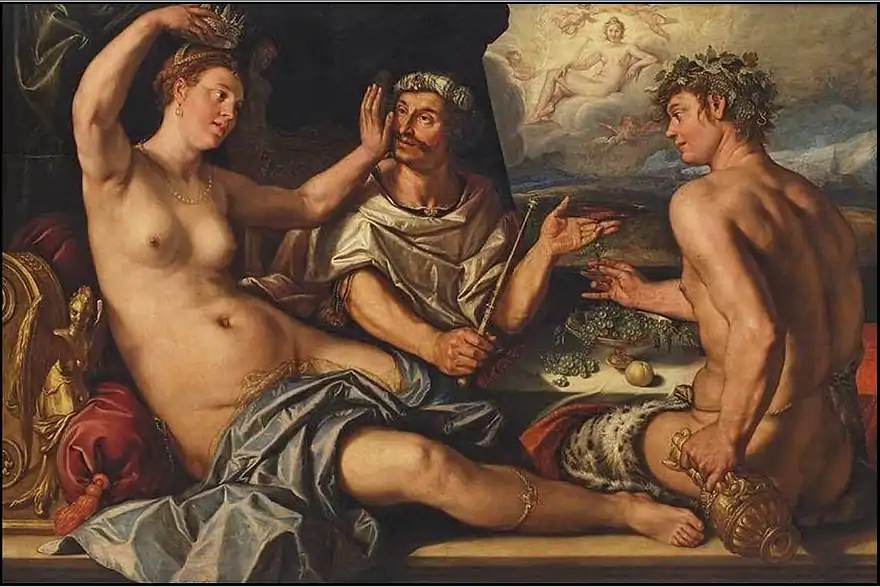Apame was first mentioned in 1 Esdras 4:29
Yet I have seen him with Apame, the king's concubine, the daughter of the illustrious Bartacus; she would sit at the king's right hand[1]
The preceding quotation is part of the Darius Contest interpolation.[2]: 20 Versions of the story, which include Apame are found in Josephus[3] and John Gower's Confessio Amantis.[4][5] Alcuin Blamire describes the "Darius Contest" as important in "the discourse of anti-misogyny."[6] The ""Darius contest" includes three versions which omit Apame.
Scholars differ as to the identity of the king mentioned in 1 Esdras 3.4 and other sources. Josephus 3.1 says the king is the son (Darius I) of Hystaspes. Vanderkam[7] also favours Darius I. Gower (vii.1889) changes the king’s name to Cirus (Cyrus the Great). Cook suggests the names may not refer to historical characters.[8]: 5 If real characters are the source, the candidates are Darius I [7] or Darius III[8]: 31 [9] or Darius III.[2]: 41 There are two theories as to the source for Apame. Coggins and Knibb[10] suggest a Persian name such as Apama or Apama II. Torrey suggests "we must look either to Egypt or Antioch."[2]: 41

References
- ↑ "Bible, Revised Standard Version". quod.lib.umich.edu.
- 1 2 3 Charles C.Torrey (1910). Ezra Studies.
- ↑ Josephus. "3.5". Antiquities of the Jews.
- ↑ John Gower. "VII.1884-1899". Confessio Amantis.
- ↑ translation is at Richard Brodie; Ellin Anderson (2009). "John Gower's Confessio Amantis Modern English version".
- ↑ Alcuin Blamire (1998). "2 The Formal Case: Origins, Procedures". The Case for Women in Medieval Culture. Oxford University Press. p. 60. ISBN 978-0-19-818630-4.
- 1 2 James C. Vanderkam (2001). An Introduction to Early Judaism. p. 60. ISBN 978-0802846419.
- 1 2 S. A. Cook (1913). "1 Esdras INTRODUCTION". In R. H. Charles (ed.). THE APOCRYPHA AND PSEUDEPIGRAPHA OF THE OLD TESTAMENT IN ENGLISH.
- ↑ not examined: Edmund Bayer (1911). Das dritte Buch Esdras und sein Verhältnis Zu Den Büchern Esra-Nehemia (German ed.). p. 116. ISBN 5874774432.
- ↑ Richard J. Coggins; M. A. Knibb (21 June 1979). The First and Second Books of Esdras. p. 30. ISBN 9780521097574.
- ↑ Ilja M. Veldman (1987). "Who Is the Strongest? The Riddle of Esdras in Netherlandish Art". Simiolus: Netherlands Quarterly for the History of Art. 17 (4): 223–239. doi:10.2307/3780619. JSTOR 3780619.
- ↑ Hendrick Goltzius. "Apame usurps the king's crown".